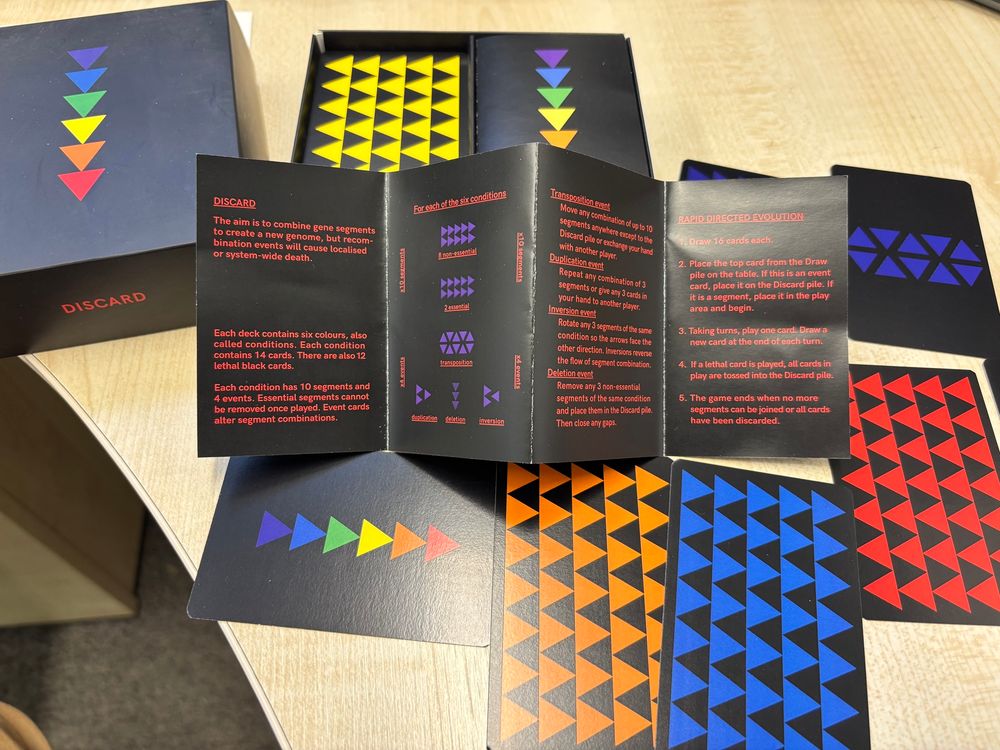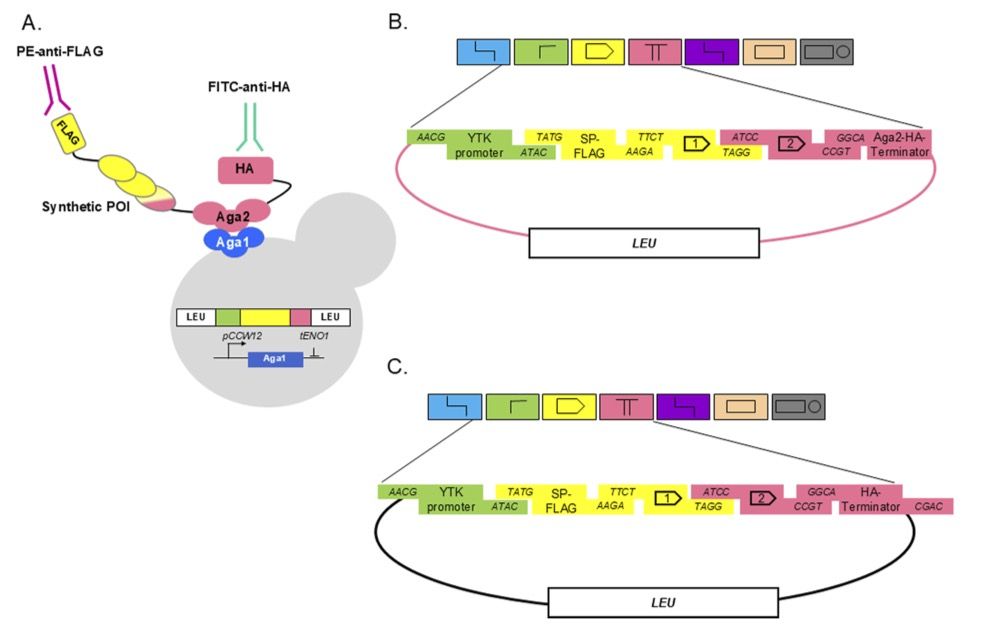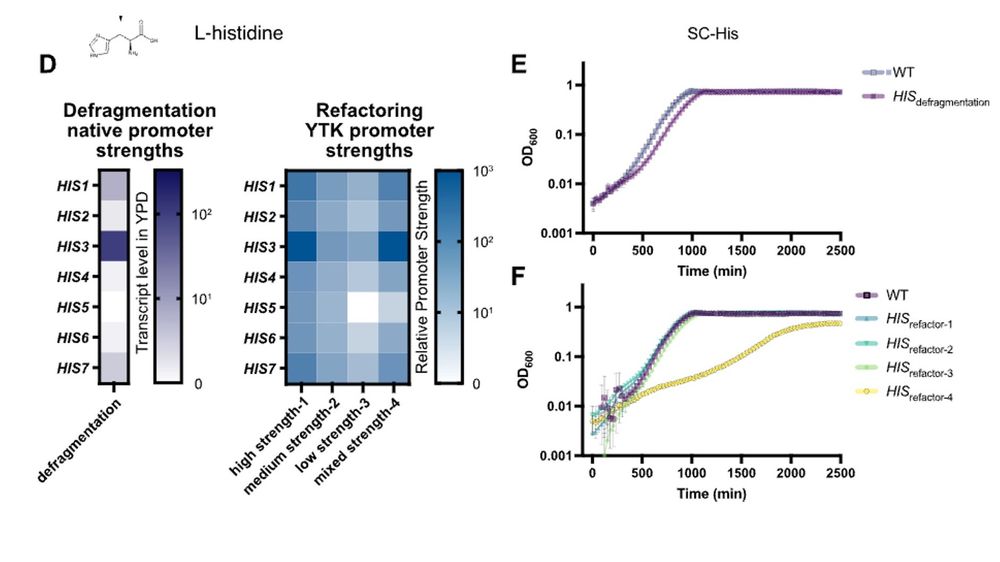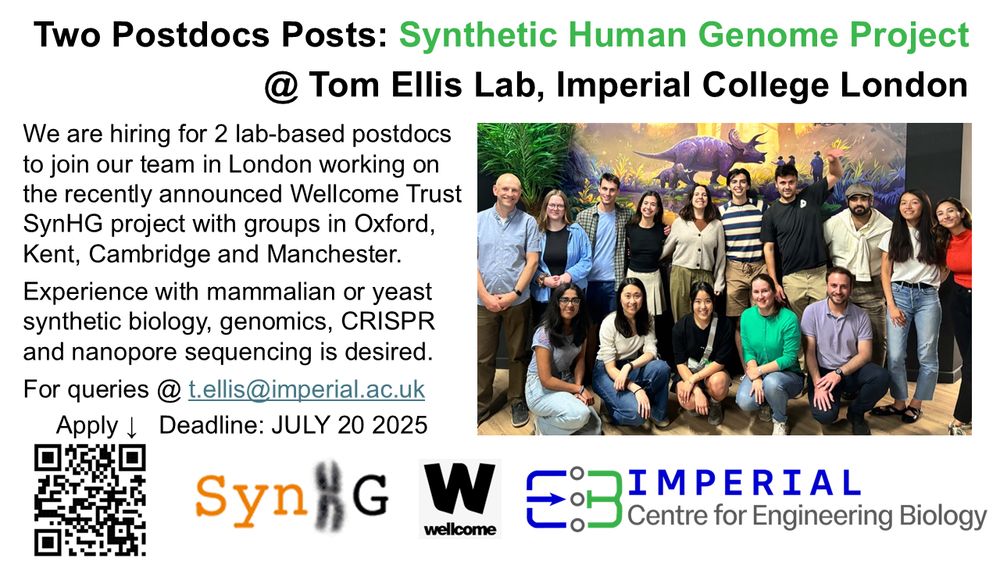
Tom Ellis
@proftomellis.bsky.social
Synthetic Biology & Synthetic Genomics @ Imperial College London and the Sanger Institute. Bilingual in English and DNA. Views are either my own or my microbes'
Was interesting to hear today about the annual “SynBio Challenges” competition that has got going in China as a cheaper/free alternative to iGEM - m.synbiochallenges.com/application/...


November 11, 2025 at 3:43 PM
Was interesting to hear today about the annual “SynBio Challenges” competition that has got going in China as a cheaper/free alternative to iGEM - m.synbiochallenges.com/application/...
Why is George Pig carrying a bacteria?

November 4, 2025 at 10:38 AM
Why is George Pig carrying a bacteria?
DISCARD - The aim is to combine gene segments to create a new genome, but recombination events will cause localised or system-wide death.

October 28, 2025 at 10:28 AM
DISCARD - The aim is to combine gene segments to create a new genome, but recombination events will cause localised or system-wide death.
A new review paper from our lab courtesy of @jazzsynbio.bsky.social is published in Trends in Biotechnology
In this review, we look at the many opportunities for synthetic biology to be used in the research and applications of Holobionts.
In this review, we look at the many opportunities for synthetic biology to be used in the research and applications of Holobionts.

October 23, 2025 at 10:09 AM
A new review paper from our lab courtesy of @jazzsynbio.bsky.social is published in Trends in Biotechnology
In this review, we look at the many opportunities for synthetic biology to be used in the research and applications of Holobionts.
In this review, we look at the many opportunities for synthetic biology to be used in the research and applications of Holobionts.
Yesterday was the first day of autumn and guess what appeared in the window of the Peninsula hotel in London.

September 23, 2025 at 9:09 PM
Yesterday was the first day of autumn and guess what appeared in the window of the Peninsula hotel in London.
It's been great to see this work develop under Stacey's expertise in our lab and so glad that it's finally out. Klaudia Ciurkot played a big role in applying the POLAR-Seq part so is an author too. We also thank Wolfgang Ott for the ELPs which made great test cases.

August 19, 2025 at 7:30 PM
It's been great to see this work develop under Stacey's expertise in our lab and so glad that it's finally out. Klaudia Ciurkot played a big role in applying the POLAR-Seq part so is an author too. We also thank Wolfgang Ott for the ELPs which made great test cases.
But in all these cases, the protein is still surface-displayed and not actually secreted, so what remained was to show that once the screen had identied a good design, that it was still a good design if it was simply secreted. Thankfully it was!

August 19, 2025 at 7:30 PM
But in all these cases, the protein is still surface-displayed and not actually secreted, so what remained was to show that once the screen had identied a good design, that it was still a good design if it was simply secreted. Thankfully it was!
This was an explosion of data - showing us the best and worst combinations of promoters and signal peptides to use for each target protein to reveal the importance of these modular parts for each case. Very useful data for informing future designs, training AI and maybe uncovering rules.

August 19, 2025 at 7:30 PM
This was an explosion of data - showing us the best and worst combinations of promoters and signal peptides to use for each target protein to reveal the importance of these modular parts for each case. Very useful data for informing future designs, training AI and maybe uncovering rules.
So armed with the modular toolkit, the YSD-based method and a FACS-based screen-and-sort approach, Stacey was able to engineer yeast cells to secrete classic enzyme targets like beta-lactamase, as well as complex structural proteins such as Elastin Like Polypeptides (ELPs).


August 19, 2025 at 7:30 PM
So armed with the modular toolkit, the YSD-based method and a FACS-based screen-and-sort approach, Stacey was able to engineer yeast cells to secrete classic enzyme targets like beta-lactamase, as well as complex structural proteins such as Elastin Like Polypeptides (ELPs).
As others have shown before, this YSD-based approach means you can label cells with epitope-binding fluorescent antibodies and then use flow cytometry to sort the ones with the most of your target protein attached to them. These should be the best secretors.

August 19, 2025 at 7:30 PM
As others have shown before, this YSD-based approach means you can label cells with epitope-binding fluorescent antibodies and then use flow cytometry to sort the ones with the most of your target protein attached to them. These should be the best secretors.
But this required a screening method that could test 1000s of cells for secretion of a target protein. For this she adapted Yeast Surface Display (YSD) to attach epitope-tagged proteins to the outside of the cells that secreted them. This was done in modular format to fit YTK.

August 19, 2025 at 7:30 PM
But this required a screening method that could test 1000s of cells for secretion of a target protein. For this she adapted Yeast Surface Display (YSD) to attach epitope-tagged proteins to the outside of the cells that secreted them. This was done in modular format to fit YTK.
Another new paper from our lab - this time from Anastasiya Kishkevich who has developed "YTK Display-and-Secrete" a library-based method to identifying genetic designs good for protein secretion from S.cerevisiae yeast. Online now at ACS SynBio - pubs.acs.org/doi/10.1021/...

August 19, 2025 at 7:30 PM
Another new paper from our lab - this time from Anastasiya Kishkevich who has developed "YTK Display-and-Secrete" a library-based method to identifying genetic designs good for protein secretion from S.cerevisiae yeast. Online now at ACS SynBio - pubs.acs.org/doi/10.1021/...
This paper was led by Jane during her PhD and included some of Glen's unpublished PhD work as well as key contributions from Klaudia Ciurkot (POLAR-Seq) and Will Shaw (CRISPR) @willshaw.bsky.social
- Always a pleasure to have amazing people like this in my group and talk about their work.
- Always a pleasure to have amazing people like this in my group and talk about their work.

August 11, 2025 at 12:36 PM
This paper was led by Jane during her PhD and included some of Glen's unpublished PhD work as well as key contributions from Klaudia Ciurkot (POLAR-Seq) and Will Shaw (CRISPR) @willshaw.bsky.social
- Always a pleasure to have amazing people like this in my group and talk about their work.
- Always a pleasure to have amazing people like this in my group and talk about their work.
Nanopore sequencing, key also to POLAR-Seq, gave Glen the genotypes of the yeast strains and allowed us to understand the gene rearrangements in the synthetic genome and hypothesize on why they boost GFP expression, but cannot easily be improved on.

August 11, 2025 at 12:36 PM
Nanopore sequencing, key also to POLAR-Seq, gave Glen the genotypes of the yeast strains and allowed us to understand the gene rearrangements in the synthetic genome and hypothesize on why they boost GFP expression, but cannot easily be improved on.
In his PhD, Glen SCRaMbLEd a synthetic yeast chromosome multiple times while selecting for maximum GFP expression from an unSCRaMbLEd plasmid. He saw quick progress on generating strains with 35% more GFP expression but by 3 rounds of SCRaMbLE it maxxed-out at 55% more.

August 11, 2025 at 12:36 PM
In his PhD, Glen SCRaMbLEd a synthetic yeast chromosome multiple times while selecting for maximum GFP expression from an unSCRaMbLEd plasmid. He saw quick progress on generating strains with 35% more GFP expression but by 3 rounds of SCRaMbLE it maxxed-out at 55% more.
This fast and affordable workflow gave us functional fitness data on thousands of rearranged synthetic genotypes - a real treasure trove. For our poor performing design, which had a weak His5 promoter, the dominating rearrangement that led to improved growth was His5 duplication.

August 11, 2025 at 12:36 PM
This fast and affordable workflow gave us functional fitness data on thousands of rearranged synthetic genotypes - a real treasure trove. For our poor performing design, which had a weak His5 promoter, the dominating rearrangement that led to improved growth was His5 duplication.
Taking a poor design, we next explored how inducible synthetic combinatorial gene rearrangement by SCRaMbLE could fix this. SCRaMbLE uses Cre-Lox recombination and is commonly used in synthetic yeast genome (Sc2.0) chromosomes. Here we placed the LoxPsym sites between genes.

August 11, 2025 at 12:36 PM
Taking a poor design, we next explored how inducible synthetic combinatorial gene rearrangement by SCRaMbLE could fix this. SCRaMbLE uses Cre-Lox recombination and is commonly used in synthetic yeast genome (Sc2.0) chromosomes. Here we placed the LoxPsym sites between genes.
She made many design variants and tested their impact on the host and the function. Most worked just fine, but if weak promoters and strong promoters were used for the wrong genes in the His biosynthesis pathway, some designs were much slower at growth in media without histidine.

August 11, 2025 at 12:36 PM
She made many design variants and tested their impact on the host and the function. Most worked just fine, but if weak promoters and strong promoters were used for the wrong genes in the His biosynthesis pathway, some designs were much slower at growth in media without histidine.
As part of her PhD, Jane first made an SGM for Histidine biosynthesis, a 7 gene function that can be essential or non-essential to cell viability based on the growth media. With CRISPR and modular synbio she relocated all 7 native genes from the genome into a refactored module.

August 11, 2025 at 12:36 PM
As part of her PhD, Jane first made an SGM for Histidine biosynthesis, a 7 gene function that can be essential or non-essential to cell viability based on the growth media. With CRISPR and modular synbio she relocated all 7 native genes from the genome into a refactored module.
Sunset in Yorkshire as I zoom to Newcastle by train to catch up with my living materials collaborators at Northumbria University. Read two proposals and two papers on this train so far. The best way to travel. 🚆

July 7, 2025 at 8:46 PM
Sunset in Yorkshire as I zoom to Newcastle by train to catch up with my living materials collaborators at Northumbria University. Read two proposals and two papers on this train so far. The best way to travel. 🚆
We're hiring for 2 postdocs to work in our lab in London on the newly announced Wellcome Trust SynHG project. If you know people looking to work on big-scale ambitious science like this, please RT and share this with them. Apply by 7/20, interviews in Aug. imperial.ac.uk/jobs/search-...

June 30, 2025 at 2:34 PM
We're hiring for 2 postdocs to work in our lab in London on the newly announced Wellcome Trust SynHG project. If you know people looking to work on big-scale ambitious science like this, please RT and share this with them. Apply by 7/20, interviews in Aug. imperial.ac.uk/jobs/search-...
An exciting week for Engineering Biology in the UK is kicked off with announcement of major commitments by the Government’s Dept of Science Innovation & Technology on both EngBio R&D (£196m initial investment) and scale-up capacity in the UK (£184m initial investment). 👏 🇬🇧 👏

June 23, 2025 at 10:41 PM
An exciting week for Engineering Biology in the UK is kicked off with announcement of major commitments by the Government’s Dept of Science Innovation & Technology on both EngBio R&D (£196m initial investment) and scale-up capacity in the UK (£184m initial investment). 👏 🇬🇧 👏
Annalise Zouein's main PhD research paper is published today in Trends in Biotech. Building and using repetitive transcription factor-binding arrays to modulate gene regulation in mammalian cells. No RNA, no protein - just DNA doing the work! www.sciencedirect.com/science/arti...

June 10, 2025 at 12:33 PM
Annalise Zouein's main PhD research paper is published today in Trends in Biotech. Building and using repetitive transcription factor-binding arrays to modulate gene regulation in mammalian cells. No RNA, no protein - just DNA doing the work! www.sciencedirect.com/science/arti...
Congrats to Dr Anastasiya Malyshava who graduates her PhD from my group and Shiyu Yu who graduates her synthetic biology MRes with her project in my lab.


June 3, 2025 at 7:28 PM
Congrats to Dr Anastasiya Malyshava who graduates her PhD from my group and Shiyu Yu who graduates her synthetic biology MRes with her project in my lab.
View from the stage at the Rpyal Albert Hall for Imperial graduation ceremony. Big place!
June 3, 2025 at 7:00 PM
View from the stage at the Rpyal Albert Hall for Imperial graduation ceremony. Big place!

